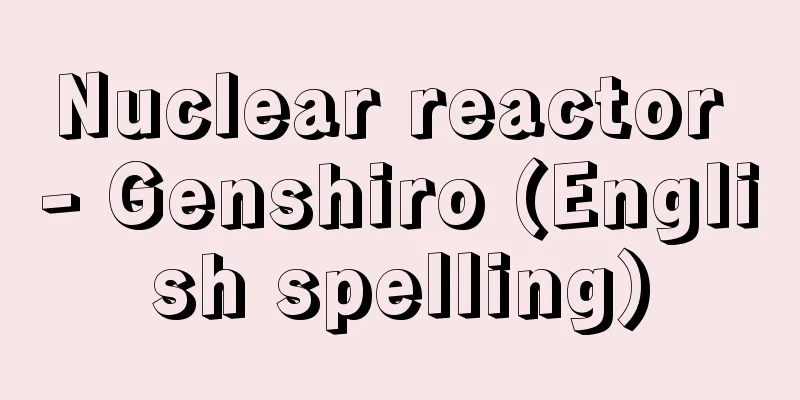Nuclear reactor - Genshiro (English spelling)

|
A device designed to artificially control a nuclear fission chain reaction using fissionable substances such as uranium and plutonium as fuel. In other words, unlike an atomic bomb, a nuclear reactor is designed to sustain a nuclear fission chain reaction and gradually extract energy, rather than causing it to occur instantly. The world's first nuclear reactor was built in 1942 by Fermi and others on the campus of the University of Chicago in Illinois, USA, by stacking graphite blocks, uranium, and uranium oxide. Nuclear reactors have been closely linked to the development of nuclear weapons from the beginning, and the success of Fermi's historic experiment was kept secret. During World War II, nuclear reactors were mainly used to produce plutonium for atomic bombs, and it was only after the war that nuclear reactors for peaceful purposes such as nuclear power generation and nuclear ships were developed. Today, nuclear reactors are used in a wide range of applications, including power generation and ship propulsion, as well as steelmaking and space development. There are also many research and production reactors, which are widely used as tools for nuclear research and development, and are also used to produce artificial radioisotopes. In Japan, university research institutes have research and testing reactors, and the Japan Atomic Energy Agency has reactors for research and testing purposes and for the development of power reactors. Meanwhile, as for commercial reactors, the Japan Atomic Power Company and electric power companies have built and operate numerous nuclear power plants throughout the country, and many more are planned and under construction. [Aoyagi Naganori] Nuclear Reactor PhysicsIn a nuclear reactor, neutrons produced by the fission of the fuel uranium-235 are absorbed by the uranium-235 nuclei again, causing nuclear fission, in a chain reaction. On average, about 2.5 neutrons are produced in one fission, but not all of them are absorbed by the fuel, but are lost through other nuclear reactions or escaping from the fuel. If the production and absorption of neutrons are not properly regulated, the fission chain reaction may increase rapidly or become unsustainable. Natural uranium contains only about 0.7% uranium-235, with the remainder being uranium-238. Uranium-235 easily undergoes nuclear fission by absorbing slow neutrons (thermal neutrons) and produces fast neutrons. Uranium-238 undergoes a small amount of nuclear fission with fast neutrons, but is a non-fissile material that absorbs a large amount of slow neutrons and produces plutonium-239. As one method of sustaining a chain reaction, enriched uranium, which has a high ratio of uranium-235 and low neutron absorption by uranium-238, is often used as fuel for nuclear reactors. However, the neutrons generated are still absorbed by the wide variety of non-fissile materials that make up the reactor, or escape from the reactor surface. In the physics of nuclear reactors, we first consider a system in which the reactor is infinitely large and neutrons do not leak out of the reactor, and then study the balance between neutron generation and absorption within that system. Fast neutrons produced by nuclear fission lose energy as they collide with the nuclei of the moderator, becoming slower thermal neutrons. Now, the period from when a neutron produced by nuclear fission is slowed down and absorbed by the fuel until it undergoes another nuclear fission is considered to be one generation of neutrons. The number that indicates how many times the number of neutrons increases when a generation changes is called the multiplication factor, and in order to realize a sustained chain reaction, this value must be 1 or more. The multiplication factor in an infinitely large nuclear reactor is determined by the following factors: (1) Fast neutrons produced by nuclear fission are absorbed by uranium 238 before being slowed down, causing nuclear fission. This increases the number of neutrons, and this is the contribution of this increase. (2) The probability that fast neutrons produced by nuclear fission become thermal neutrons without being absorbed by uranium 238 (resonance absorption) while being slowed down. (3) The proportion of slowed down thermal neutrons that are absorbed in the fuel (neutron utilization rate). (4) The average number of neutrons of the next generation that are produced when one neutron is absorbed by fuel and undergoes nuclear fission. The product of the above four factors results in an infinitely large multiplication factor for a nuclear reactor, and the equation that expresses this relationship is called the four-factor formula. In an actual nuclear reactor, the system containing the fuel (core) is finite, and in order to reduce the leakage of neutrons generated in the core, the core is surrounded by reflective material to return leaking neutrons back to the core, but a certain percentage still leaks out of the system. Therefore, in a finite reactor, the actual multiplication factor is the multiplication factor that the reactor would have if it were infinitely large, multiplied by the probability that neutrons are absorbed within the system and do not leak out of the system. The former is called the infinite multiplication factor, while the multiplication factor of an actual finite reactor is called the effective multiplication factor. In a nuclear reactor, when the effective multiplication factor is 1, exactly one of the neutrons produced in one nuclear fission is absorbed by the fuel and undergoes nuclear fission, generating the next generation of neutrons, allowing the chain reaction to continue steadily. This state is said to be the critical state of the nuclear reactor. If the effective multiplication factor is less than 1, the chain reaction will shrink and become unsustainable, and this state is called subcritical; conversely, if it is greater than 1, the chain reaction will grow and become supercritical, entering a state of supercriticality. Neutron leakage occurs on the surface of the core, but neutrons are generated inside the core. Because the increase in surface area is small compared to the increase in volume of the core, the probability of neutron leakage decreases as the core grows. Therefore, when fuel is added to a single core, the probability of no neutron leakage increases, causing the reactor to go from a subcritical state to a critical state, and eventually to a supercritical state. The amount and volume of fuel contained in the core when the reactor reaches a critical state are called the critical mass and critical magnitude of that reactor. To operate a nuclear reactor steadily, strong absorbers of thermal neutrons (control rods) are inserted into the core, which is loaded with fuel to the extent that it is slightly over critical, and the critical state is maintained by absorbing the excess neutrons that are generated when the reactor is over critical, thereby balancing the generation and absorption of neutrons. The above explanation is about the principles of the type of nuclear reactor known as a thermal neutron reactor, which is the most common type currently in existence; the principles of fast neutron reactors and the like are somewhat more complicated. [Aoyagi Naganori] Reactor power and thermal engineeringThe radiation produced by nuclear fission reactions undergoes various processes, but ultimately becomes heat. The power (thermal output) of a nuclear reactor is determined by the number of nuclear fission reactions that occur in the core per unit of time, and is the amount of energy released in units of heat. Theoretically, by increasing the number of nuclear fission chain reactions in the core, the energy released per unit of time would be almost infinite, making it possible to create a reactor of unlimited power output, but in reality it is determined by the rate at which the reactor can remove heat. 80% of the energy from nuclear fission becomes the kinetic energy of the fission fragments, which immediately turns into heat and all of it is generated as heat in the fuel, but the remaining 20% also becomes the kinetic energy of gamma rays and neutrons. In a thermal neutron reactor, about 90% of the total heat generated by nuclear fission is generated in the fuel, so the transfer of heat between the fuel and the coolant that flows between the various structures is important. Once the heat distribution in the fuel is determined, the temperature distribution in the fuel body, structures, and coolant will also be determined, but in this case, the thermal conduction in each element and the heat transfer to the coolant are important, and particular attention must be paid to changes in heat transfer due to the boiling of the coolant. In thermal engines, the mechanical properties of the structures are considered, but in nuclear reactor materials, the nuclear physics properties are the main priority, and materials with excellent thermal, physical, and mechanical properties are not necessarily selected. Therefore, in order to prevent cracks in the materials caused by thermal stress and chemical corrosion, and melting at high temperatures, it is necessary to design the fuel and structural materials so that their temperatures are kept within a certain range and do not rise or fall below that range, and to avoid large temperature gradients or large thermal fluctuations. In general, strict thermal design of nuclear reactors is carried out in the midst of the conflicting demands of increasing the temperature and heat release rate to obtain maximum thermal output and maximum thermal efficiency, and preventing thermal stress, chemical corrosion, and deterioration of materials under long-term high neutron densities. In particular, careful material selection and improvements in thermal design are becoming important points for the development of nuclear reactor technology, since the destruction of fuel and structural materials causes safety problems such as the release of highly radioactive fission products. [Aoyagi Naganori] Reactor MaterialsIn a broad sense, reactor materials can include the fissile material contained in the fuel assemblies, but usually do not include these. They can also include fuel cladding, coolant, moderator, reflector, shielding, neutron absorbing materials, other reactor core structural materials, primary system structural materials, steam generator materials, and containment vessel materials, but generally the term is limited to the reactor core structural materials, and only materials specific to the reactor are added. The materials used to make the reactor core vary slightly depending on the type and model of the reactor. Other materials were researched for reactors that never reached practical use, and are being researched and developed for future use. Beryllium and its alloys, niobium alloys, and vanadium alloys are examples of materials that never reached practical use as fuel cladding materials, and the sodium-potassium eutectic alloy NAC is used in research irradiation capsules but is not used as a reactor coolant. Molten salt fuel and liquid metal fuel reactors have also only been researched and developed and have not yet been put to practical use. Aqueous uranyl sulfate fuel was used in Japan's first research reactor, JRR-1 (now dismantled). A nickel alloy called Ainol 8 was also developed as a container material for molten fluoride salt fuel. The reactor materials actually used can be broadly divided into: (1) conventional industrial materials manufactured with slight modifications to their specifications for use in reactors, (2) improved conventional industrial materials (such as new alloys) developed for use in reactors, and (3) new metals (so-called new metals) and alloys that are newly industrially produced for the sole purpose of being used in reactors. Examples of (1) include aluminum alloys for research reactors, and stainless steels and low-alloy steels for power and research reactors; examples of (2) include Magnox, boron-containing steels, and Boral, which are used as fuel cladding materials for carbon dioxide-cooled reactors; examples of (3) include zirconium alloys, sodium, hafnium, and oxides of rare earth elements for neutron absorption. [Ryōtsugu Mishima] Components of a Nuclear ReactorA nuclear reactor is usually composed of a core, reflector, shielding, cooling system, and measurement and control equipment. The core, which consists of the fuel that causes the nuclear fission chain reaction and a moderator that slows down the neutrons, is the most important part of the reactor. The reflector surrounds the core and acts to reflect neutrons escaping from the core and return them to the core. The shielding blocks the powerful radiation flowing from the core and prevents it from leaking outside the reactor. Meanwhile, the cooling system circulates coolant through the core, reflector, shielding, etc., and removes the heat that is generated. The measurement and control equipment is used to insert and remove control rods made of powerful neutron absorbers into and from the core, control the reactor power output, and also to measure and record the power output, temperature, neutron density, pressure, and radiation strength. [1] Fuel assemblies Nuclear fuel materials include uranium-235, plutonium-239, and uranium-233, but most are enriched uranium, which is made by separating and enriching natural uranium and uranium-235 to increase their abundance ratio. Although plutonium-containing fuel is becoming practical, thorium fuel, which uses uranium-233 produced from thorium-232, is not yet in general use. Nuclear fuel materials are formed into cylindrical (pellet) plates or hollow cylindrical shapes in the form of metals, metal alloys, oxides, etc., and are coated with aluminum alloys, zirconium alloys, stainless steel, etc. Although there may be a single fuel assembly, it is usually in the form of a fuel assembly, in which fuel plates or fuel pellets are stacked and inserted into cladding tubes and sealed, forming multiple fuel rods, which are then placed in a support mechanism. The cladding material is used to prevent the dispersion of gases (fission products) generated within the nuclear fuel material and to prevent chemical erosion caused by impurities in the fuel material and by interactions between the fission products and the coolant; therefore, a material that is resistant to the chemical action of the coolant and that absorbs little neutrons is selected. [2] Moderators and reflectors The neutron moderation effect is more effective for atomic nuclei with smaller mass numbers close to the mass of the neutron, but on the other hand, the less neutrons are absorbed, the better. Usually, light water (ordinary water), heavy water, beryllium, beryllium oxide, graphite, etc. are used. The reflector should be the same material as the moderator, but it can also be used in combination with the moderator. [3] Coolants Gaseous carbon dioxide, helium, liquid light water, heavy water, molten sodium, etc. are used as coolants. Gaseous coolants have poorer thermal conductivity than liquids and require more power for the circulation pump to remove heat, but they have the characteristic of absorbing fewer neutrons and being able to reach high temperatures. Helium gas has excellent properties as a coolant and is used in high-temperature gas-cooled reactors, but it is expensive. Carbon dioxide is inexpensive and has the advantage of generating less radioactivity than liquids, so it is used in Calder Hall type reactors. Light water is the most widely used liquid coolant because it is cheap, easy to obtain, and can be used as a moderator. Its drawbacks are that it boils at high temperatures and its thermal conductivity drops, so the cooling system must be pressurized, and it also absorbs a relatively large amount of neutrons, making it prone to radioactivity due to impurities. Heavy water has the advantage of absorbing fewer neutrons and acting as both a moderator and reflector, but it also has the disadvantages of generating tritium and being more expensive than light water. Liquid sodium has excellent physical properties as a coolant, with high conductivity, great cooling capacity, and a high boiling point, but is chemically active and poses the risk of explosion when it reacts with water. It requires careful design and special technology, and is mainly used in fast neutron reactors. [4] Shielding materials Shielding materials are made of materials that effectively absorb strong radiation, such as neutrons and gamma rays, that leak from the reactor core. Types include hydroxides that contain a lot of water and hydrogen, boron and its compounds, metals such as iron, lead, and cadmium, and heavy concrete that contains large amounts of these. The parts that come into contact with the reactor core and reflector absorb gamma rays and fast neutrons and generate heat, so light water tanks that are easy to remove heat from or iron with a high melting point are placed therein to prevent damage to the shielding itself due to heat generation, and the surrounding area is surrounded by heavy concrete or other shielding materials. The former is called thermal shielding, and the latter is called biological shielding. [Aoyagi Naganori] Reactor typesNuclear reactors can be classified according to their intended use, or according to differences in reactor principle, fuel, materials, and structure. An example of the latter is a thermal neutron reactor, which causes nuclear fission reactions with thermal neutrons, and a fast reactor, which causes nuclear fission reactions mainly with fast neutrons. The value that indicates the average number of new fissile materials produced by the neutrons produced in one nuclear fission is called the conversion ratio, and reactors with a conversion ratio of 1 or more are called breeder reactors, and those with a conversion ratio of less than 1 are called converter reactors. [1] Research reactors: Generally speaking, research reactors are reactors whose main purpose is to be used for nuclear research and development, as opposed to power reactors. Purposes of use include research using neutron beams and other radiation from the reactor as a radiation source, research into the effects and influences of neutron irradiation on materials and living organisms, research into the reactor itself, research and development of reactor instrumentation equipment, production of plutonium and radioisotopes, medical applications, and education and training of nuclear engineers. There are various types of reactors, ranging from zero-power critical experiment devices to thermal output of hundreds of thousands of kilowatts, and they can achieve high neutron density and flow relative to their thermal output. In general, the temperature of the coolant is low, and the heat normally generated is not utilized. (1) Water boiler type: This type of reactor was widely built in the early days of nuclear reactor development, and its spherical core contains fuel made of a homogeneous mixture of enriched uranium in uranyl sulfate and light water as a moderator. The JRR-1 reactor of the Japan Atomic Energy Research Institute (now the Japan Atomic Energy Agency), which became Japan's first nuclear reactor in 1958 (Showa 33), was of this type (it ceased operation in 1968, and dismantling work was completed in 1970). (2) Swimming pool type: A fuel assembly is made by arranging several sheets of enriched uranium aluminum alloy fuel shaped into plates. The core, made up of several of these fuel sheets, is placed in the bottom of an open vessel (pool) filled with light water and surrounded by a graphite or beryllium reflector. The pool water serves three purposes: moderation, cooling, and shielding. The core can be seen directly with the naked eye, and it is used in a wide range of applications, including shielding experiments, neutron irradiation experiments, and education and training. JRR-4 at the Japan Atomic Energy Agency and KUR at Kyoto University are examples of this type. (3) Tank type: Both the fuel and moderator are housed in a sealed container (core tank), and the moderator/coolant in the tank is pressurized and circulated with a pump to cool it. This allows for high output and a high neutron density and flow. Fuel can range from natural uranium to highly enriched uranium, and there are many different fuel structures. Many unique reactor types can be created by combining the moderator and coolant with light water or heavy water. Japan Atomic Energy Agency's JRR-2 and 3 are reactors of this type (JRR-2 ceased operation in 1996). (4) Materials Testing Reactor: It has high power and neutron density, and its main purpose is irradiation testing of reactor materials. Highly enriched uranium is made into aluminum alloy plate fuel and placed in the core tank. Light water, which acts as a moderator and coolant, is circulated under high pressure inside the core tank, and the core tank is further placed in a light water pool. The Japan Materials Testing Reactor (JMTR) of the Japan Atomic Energy Agency in Oarai Town, Ibaraki Prefecture is of this type. (5) Trigger type: This type of reactor has a structure in which fuel rods made of an alloy of enriched uranium and zirconium hydride are bundled together and placed in a cylindrical container filled with light water. It has a relatively low output and is stable, and is used for experiments and education and training. Rikkyo University and Musashi Institute of Technology have this type of reactor. (6) High Neutron Flux Reactor: A nuclear reactor that generates a high neutron density and flow by increasing the output from a small core for research into the arrangement and movement of atoms and molecules using neutron beams, for the production of transuranium elements, and for irradiation testing of materials. There are many reactors of this type overseas, but none in Japan yet. Recently, various countries have been working on the design and development of ultra-high neutron flux reactors that can achieve performance that exceeds that of high neutron flux reactors. (7) Other research reactors There are small, low-power experimental neutron source reactors, such as the Yayoi fast neutron source reactor of the University of Tokyo, and pulsed reactors, such as the NSRR of the Japan Atomic Energy Agency, which can intermittently increase the power and produce a high neutron density and flow even for a short period of time. [2] Power reactors Power reactors require a large thermal output, so the entire facility, including auxiliary equipment such as heat exchangers and turbines, and safety devices, is large. In addition, in order to compete with other energy sources such as oil, strict technical requirements are placed on the design, construction, and operation of the reactor to maintain an advantage in terms of safety and economic efficiency. The practical application of a power reactor requires a long-term, multi-stage development process, including the selection of the reactor type and the setting of development goals, basic technological development, research and development using experimental and test reactors, the construction and operation of a prototype reactor to verify the functionality and safety of the target reactor, and the construction and operation of a commercial practical reactor. [Aoyagi Naganori] Nuclear reactors used as practical reactors(1) Light water reactors: Reactors that use light water as a moderator and coolant. There are pressurized water reactors (PWRs), which circulate the coolant by pressurizing the cooling system to prevent the water from boiling, and boiling water reactors (BWRs), which circulate the steam boiled in the core as is. Pressurized water reactors have a steam generator and are separated into a primary and secondary system, but boiling water reactors send the steam generated in the core directly to the turbine. Pressurized water reactors were developed in the United States long ago to propel nuclear submarines, but the first commercial power plant to be put into practical use as a power plant was in 1956 at Shippingport, Pennsylvania. The first boiling water reactor to be put into practical use was the Dresden Power Plant, which was completed in 1957 and began commercial operation in 1960. Since then, light water reactors have become larger, and currently there are large reactors with an electrical output of 1.5 million kilowatts. (2) Natural uranium-graphite-moderated gas-cooled reactor The Calder Hall reactor, developed early on in the UK, is famous for using natural uranium as fuel, graphite as a moderator, and carbon dioxide as a coolant. Japan's first commercial power plant, the Tokai No. 1 reactor at the Japan Atomic Energy Agency, was an improved Calder Hall reactor, but all power plants built in Japan since then have been light water reactors. (3) Graphite-moderated light water-cooled reactor: Developed long ago in the former Soviet Union, this type of reactor has a core structure in which light water flows around each fuel rod in a graphite block used as a moderator (channels). Currently, there are large reactors with an electrical output of 1.5 million kilowatts. Also called the RBMK reactor, it is famous as the reactor that caused the Chernobyl nuclear power plant accident. (4) CANDU Reactor: A reactor that uses natural uranium as fuel and heavy water as a moderator and coolant. It was developed in Canada and is exported overseas, but is not available in Japan. [Aoyagi Naganori] Power reactors under development(1) Advanced Thermal Reactors Light water reactors, which account for the majority of power plants currently in operation or under construction, require enriched uranium and have a low conversion rate, making it possible to use only a portion of uranium resources. In Japan, the Power Reactor and Nuclear Fuel Development Corporation (later the Nuclear Fuel Cycle Development Organization, now the Japan Atomic Energy Agency) built the Advanced Thermal Reactor "Fugen," which uses heavy water moderated, light water cooled uranium fuel and plutonium oxide fuel as a new type of thermal neutron reactor with a high conversion rate, and began operation in 1979. However, although construction of a commercial reactor was planned in Japan, it was canceled in 1995, mainly due to the lack of economic viability. "Fugen" ceased operation in 2003. (2) Fast breeder reactors These have been developed in various countries as reactors that mainly use fast neutron fission reactions and can produce plutonium faster than fuel can be consumed. In Japan, the Power Reactor and Nuclear Fuel Development Corporation's fast breeder experimental reactor "Joyo" began operation in 1977, and the fast breeder prototype reactor "Monju" began operation in 1994, but has been shut down since a sodium leak accident in 1995 (it is currently owned by the Japan Atomic Energy Agency). (3) Inherently safe reactor: A reactor designed with a new safety design concept that prevents reactor runaway and loss of cooling water accidents. The laws of nature ensure that the reactor can be shut down in an emergency and the heat from the core can be removed. Many countries are currently working on the development of relatively small reactors with an electric output of around 600,000 kilowatts. (4) High-Temperature Gas-Cooled Reactors Multipurpose high-temperature gas-cooled reactors have been developed around the world, and in Japan, the Japan Atomic Energy Agency's High Temperature Engineering Test Reactor (HTTR) is currently undergoing testing. (5) Molten Salt Breeder Reactor This is a thermal neutron reactor that uses thorium to breed the nuclear fuel uranium 233. Its greatest feature is that it uses molten salt fuel made by dissolving nuclear fuel and thorium fluoride and oxide, and performs power generation and fuel reprocessing in one unit. [Aoyagi Naganori] Nuclear Reactor SafetyIn nuclear reactors, a huge amount of radioactivity is generated as a result of nuclear fission. For example, in a light water nuclear power plant with an electric output of 1 million kilowatts, about 3 kilograms of uranium undergo nuclear fission per day, producing the same amount of fission products (fallout). It is estimated that about 1 kilogram of uranium 235 underwent nuclear fission in the atomic bomb dropped on Hiroshima, so the amount of fallout accumulated in a large nuclear reactor can be estimated as being enormous. The amount of radioactivity accumulated immediately after shutting down after one year of operation is calculated to be 17.3 billion curies, and the decay heat also reaches 200,000 kilowatts. In addition, there is radioactivity (such as cobalt 60) that is generated by the activation of the reactor structural materials by the action of neutrons, but the amount of this is about one thousandth of the fallout. The danger of a nuclear reactor refers to the potential danger of the existence of this huge amount of accumulated radioactivity, and the safety of a nuclear reactor is the issue of how to reliably contain it within the reactor and prevent it from becoming apparent. One of the major accidents that can occur in nuclear reactors is a reactivity accident, in which a chain reaction cannot be controlled for some reason, and the sudden increase in reaction causes the reactor to go out of control. In April 1986, the largest accident in the history of practical power reactors occurred at the Chernobyl Nuclear Power Plant Unit 4 in the Soviet Union (after the collapse of the Soviet Union in 1991, Chernobyl became part of Ukraine). This accident occurred during a special experiment just before the reactor was shut down after a long period of continuous operation, when the reactor went out of control, causing extensive damage to the reactor and the building. A huge amount of deadly fallout spewed from the reactor and spread to neighboring countries of the Soviet Union. According to a 1996 report by the International Atomic Energy Agency, the damage from the accident was said to be 30 deaths, 134 people with acute radiation injuries, approximately 116,000 residents who were evacuated due to high levels of radiation contamination, and 200,000 people who were exposed to relatively high levels of radiation during recovery work. Furthermore, as a form of radiation damage, the number of cases of childhood thyroid cancer has rapidly increased to approximately 800 in Belarus and Ukraine by the end of 1995. Later, in September 2005, 20 years after the accident, a report was published by a group of experts led by the International Atomic Energy Agency. According to the report, 47 people had died of cancer and other causes due to direct exposure to radiation from the accident, and 9 children had died of childhood thyroid cancer, and it was estimated that, including these people, the number of deaths due to direct exposure in the future would reach 4,000. However, this figure was criticized by Greenpeace International and others as being too low. Another major accident, especially in light water reactors, is a loss of coolant accident (LOCA), in which the cooling water is lost for some reason, the core goes into a dry-burn state, and the fuel melts due to heat. An example of this is the accident at the Three Mile Island Nuclear Power Plant Unit 2 in Pennsylvania, USA, in March 1979. In this accident, a mechanical malfunction was the cause of the loss of coolant accident, which was compounded by human error, damaging the core and releasing a large amount of radiation for a long period of time, and many residents, up to 200,000 people, were evacuated. Light water power reactors have an emergency core cooling system (ECCS) that injects additional cooling water as soon as a loss of coolant accident occurs, but if emergency cooling water is not supplied for some reason, it is thought that even if the reactor is shut down, the fuel temperature will rise due to the large amount of heat generated by the radioactive fission products in the fuel body, and the melted fuel will fall into the bottom of the pressure vessel due to the melting of the cladding material. This state is called core melting, and a melted high-temperature fuel or cladding material and residual water may react to generate hydrogen, which may cause an explosion when oxygen is combined. Furthermore, if the coolant is completely lost, the melt accumulates at the bottom of the pressure vessel, penetrates the container and the lower concrete, and finally enters the ground. In fact, in the Three Mile Island accident, more than half of the core's fuel melted, accumulated at the bottom of the pressure vessel, and almost flows out of the container a little further. In the aftermath of the accident, investigations revealed. Such major accidents that exceed the ones envisaged by the safety design of nuclear reactors are called cruel accidents, but after the Chernobyl accident, Japan has also started to consider measures to combat severe accidents. になったんです。 English: The first thing you can do is to find the best one to do. In Japan, similar content is set in the "Review Guidelines for Safety Design for Light Water Reactors" for power generation reactors. In addition, earthquake-resistant design standards for earthquake-related accidents have recently become a particularly problematic. There have been many historical debates over whether a nuclear reactor that meets the standards for safety inspections is sufficient. However, large-scale power reactors that are currently the mainstream cannot completely deny the occurrence of severe accidents. Therefore, after two major accidents, there have been various controversies, such as the current engineering safety standards not ensuring sufficient safety, the safety inspection standards and safety inspection systems of nuclear disasters are defective, and the disaster prevention system and emergency measures in the event of severe accidents are insufficient. It has been pointed out internationally that nuclear power officials are "assumptions about safety and overconfidence." Considering that nuclear reactor technology is still inexperienced, and the engineering safety of many reactors is still not fully demonstrated, it can be said that much basic research and development is needed for the use of energy using nuclear reactors in the future. [Aoyagi Naganori] "Nuclear Energy: Its Principles and Applications" by R.L. Murray, translated by Endo Yuzo (1981, Corona Publishing) [Reference Items] | | | | | | Nuclear | | | | | |©Shogakukan "> Principles of nuclear fission and control in nuclear reactors ©Shogakukan "> Emergency core cooling system for pressurized water reactors Source: Shogakukan Encyclopedia Nipponica About Encyclopedia Nipponica Information | Legend |
|
ウランやプルトニウムなど核分裂をおこす物質を燃料とし、核分裂連鎖反応を人為的に制御するように考案された装置。つまり、原子炉は、原子爆弾のように核分裂連鎖反応を瞬時におこさせるのではなく、持続させ徐々にエネルギーを取り出すようにつくられている。 第二次世界大戦中の1942年にアメリカのイリノイ州シカゴ大学構内に、フェルミらにより、黒鉛ブロックとウラン、酸化ウランを積み重ねた装置がつくられたのが世界最初の原子炉である。原子炉は最初から核兵器の開発と深く結び付いていて、フェルミらの歴史的実験の成功も秘密にされていた。第二次大戦中、原子炉はおもに原子爆弾用のプルトニウムの生産などに使われ、原子力発電や原子力船などの平和利用の原子炉が開発されたのは、戦後のことである。現在では、原子炉の利用は多方面にわたり、動力用として発電、船舶推進に、そのほか製鉄や宇宙開発などへの利用も進められている。研究・生産用原子炉も多く、広く原子力の研究・開発のための道具として利用され、また人工の放射性同位元素(ラジオ・アイソトープ)の生産なども行う。 日本には、大学研究機関に研究・試験用原子炉が、日本原子力研究開発機構に研究・試験用および動力用原子炉の開発を目的とする原子炉がある。一方、商業用原子炉としては、日本原子力発電会社と電力会社が全国各地に数多くの原子力発電所を建設・運転しており、また計画・建設中の炉も多数ある。 [青柳長紀] 原子炉の物理原子炉では、燃料のウラン235の核分裂で発生する中性子がふたたびウラン235の原子核に吸収され核分裂をおこす連鎖反応がおきている。1回の核分裂で平均2.5個程度の中性子が発生するが、そのすべてが燃料に吸収されるわけでなく、別の核反応や燃料の外へ逃げて失われていく。中性子の発生と吸収をうまく調節しないと核分裂連鎖反応が急激に増大したり、持続しなくなったりしてしまう。天然ウランは、ウラン235が全体の0.7%程度しか含まれず、残りはウラン238である。ウラン235は、速度の遅い中性子(熱中性子)を吸収して容易に核分裂をおこし、速度の速い中性子を発生させる。ウラン238は速い中性子でわずかに核分裂をおこすが、一方では速度の速くない中性子を多量に吸収し、プルトニウム239を生み出す非核分裂性物質である。連鎖反応を持続させる方法の一つとして、原子炉の燃料では、ウラン235の存在比を高くし、ウラン238への中性子の吸収を少なくした濃縮ウランが多く使われる。それでも、発生した中性子は、原子炉を構成している多種多様な非核分裂性物質に吸収されたり、原子炉表面から逃げ出したりする。原子炉の物理学では、まず原子炉が無限に大きくて中性子が炉の外に漏れていかないような体系を考え、その中での中性子の発生と吸収のバランスを研究する。 核分裂で発生した速い中性子は、減速材の原子核に衝突しながらエネルギーを失って減速され、速度の遅い熱中性子になる。いま、核分裂で発生した中性子が減速され燃料に吸収されてから再度核分裂をおこすまでを中性子の1世代と考え、世代がかわったときに中性子の数が何倍になるかを表す数を増倍率というが、持続する連鎖反応を実現するには、この値が1以上でなければならない。無限に大きい原子炉での増倍率は次のような因子で決まる。(1)核分裂により発生した速い中性子は減速される前にウラン238に吸収され核分裂をおこす。これによって中性子個数が増加する、その寄与分。(2)核分裂で発生した速い中性子が減速される途中で、ウラン238に吸収される(共鳴吸収)ことなく熱中性子になる確率。(3)減速された熱中性子のうち燃料の中に吸収される割合(中性子利用率)。(4)1個の中性子が燃料に吸収され核分裂をおこしたとき発生する次の世代の中性子の平均個数。以上四つの因子の積として無限に大きな原子炉の増倍率が現れるが、この関係を表す式を四因子公式という。 実際の原子炉では、燃料の入った体系(炉心)は有限であり、炉心で発生した中性子の漏れを少なくするため、炉心の周囲を反射材で囲み、漏れる中性子を炉心に返すようにするが、それでも一定の割合で体系外に漏れる。そこで有限の原子炉では、その原子炉が無限に大きいと考えたときにもつ増倍率に、中性子がその体系内で吸収され系外に漏れていかない確率を掛けた値が実際の増倍率となる。前者を無限増倍率というのに対し、実際の有限の炉の増倍率を実効増倍率という。 原子炉では実効増倍率が1のとき、ちょうど1回の核分裂で発生した中性子のうちの1個だけが燃料に吸収され核分裂をおこし、次の世代の中性子を発生させることになり、連鎖反応は定常的に持続できる。この状態を原子炉は臨界であるという。実効増倍率が1より小さいと、連鎖反応は縮小していき持続できなくなるが、この状態を臨界未満といい、逆に1より大きいと連鎖反応が増大していく臨界超過の状態となる。 中性子の漏れは炉心の表面でおこるが、中性子は炉心の中で発生する。炉心部分の体積の増加に対し表面積の増加の割合は小さいので、炉心の増大に対し中性子の漏れる確率は小さくなる。したがって、ある一つの炉心に燃料を増加させていくと、中性子の漏れない確率の増加で、原子炉は臨界未満の状態から臨界に達し、やがて臨界超過の状態になる。原子炉が臨界の状態になったときの炉心に含まれる燃料の量および容積を、その原子炉の臨界量および臨界の大きさという。 原子炉を定常的に運転するには、燃料が臨界をやや超過する程度まで装荷した炉心の中に、熱中性子の強吸収体(制御棒)を挿入し、臨界超過で余分に発生する中性子を吸収することで中性子の発生と吸収のバランスをとり、臨界状態を保つ。以上の説明は、現在もっとも多く存在する熱中性子炉とよばれる形の原子炉の原理についてのもので、高速中性子炉などの原理はやや複雑となる。 [青柳長紀] 原子炉出力と熱工学核分裂反応で発生する放射線はいろいろの経過をたどるが、最終的には熱になる。原子炉の出力(熱出力)は、炉心の中で単位時間におこる核分裂反応の数で決まり、発生するエネルギーを熱の単位で表したものである。理論的には、炉心内で核分裂連鎖反応を増大させれば単位時間に放出するエネルギーは、ほとんど無限に近くいくらでも大きな出力の原子炉ができることになるが、実際にはその炉の熱除去のできる割合で決まってしまう。 核分裂エネルギーの80%は核分裂破片の運動エネルギーとなり、すぐに熱になり、すべて燃料中で発熱するが、その他の20%はγ(ガンマ)線や中性子の運動エネルギーなどにもなる。熱中性子炉では、核分裂による全発熱量の90%程度が燃料中で発生するので、燃料といろいろな構造物の間を流れる冷却材との熱の受け渡しがたいせつである。燃料中の発熱分布が決まれば、燃料体、構造物、冷却材各部の温度分布が決まるが、その場合、各要素中の熱伝導と冷却材への熱伝達が重要で、とくに冷却材の沸騰による熱伝達の変化に注意を要する。 火力の熱機関では構造物は機械的性質を考えて選ばれるが、原子炉材料ではおもに核物理学的性質が優先され、熱的、物理的、機械的に優れた素材が選ばれるとは限らない。したがって、熱応力や化学的腐食による材料の割れの発生や高温での溶解を防止するため、燃料体や構造材の温度を一定の範囲内に抑え、それより上昇したり低下したりしないようにすることや、温度勾配(こうばい)を大きくしたり熱的変動を大きくしないような設計が必要となる。一般に最大の熱出力と最大の熱効率を得るために高温化と熱放出率を高めようとする要求と、熱応力、化学的腐食、長期間の高い中性子密度の中での材料の劣化などを防止するという相反する要求のなかで、厳しい原子炉の熱的設計がなされる。とくに最近では、燃料体や構造材の破壊は核分裂生成物の高い放射能の放出という安全上の問題をおこすため、慎重な材料の選択と熱設計上の改良が原子炉の技術を発展させるための重要なポイントになりつつある。 [青柳長紀] 原子炉材料原子炉材料は、広義では燃料体の中身の核分裂性物質をも含むことがあるが、普通はこれを含まない。燃料被覆材、冷却材、減速材、反射体材、遮蔽(しゃへい)材および中性子吸収材、その他の炉心構造材、一次系構造材、蒸気発生器材から格納容器材まで入れることもあるが、一般には炉心構造材までにとどめ、あとは原子炉固有の材料を加えるにとどめる。 原子炉の炉心をつくるのに使用される材料は、原子炉の種類、型式によって若干違う。このほか実用に至らなかった原子炉のために研究された材料や、今後の使用を目標に研究開発されているものがある。燃料被覆材としてのベリリウムおよびその合金、ニオブ合金、バナジウム合金は実用に至らなかった例であり、ナトリウム‐カリウムの共晶合金ナックは研究照射カプセルには封入して使われるが、原子炉の冷却材には実用されない。また融解塩燃料、液体金属燃料の炉も研究開発のみで実用には至っていない。硫酸ウラニル水溶液燃料は日本最初の研究炉JRR‐1(すでに解体された)には用いられた。またフッ化物の融解塩燃料に対する容器材としてアイノール8というニッケル合金が開発されたことがある。 実際に用いられる原子炉材料を大別すると、(1)旧来からの工業材料を原子炉用に若干仕様を変更して製造させて使うものと、(2)原子炉用に開発された旧来の工業材料の改良材(新合金など)と、(3)まったく原子炉用を目標に新たに工業生産されるようになった金属(いわゆる新金属)および合金とになる。 (1)の例は研究炉用のアルミ合金、動力炉・研究炉用のステンレス鋼や低合金鋼があり、(2)には炭酸ガス冷却炉用の燃料被覆材のマグノックスやボロン入り鋼、ボラールがあり、(3)の例はジルコニウム合金、ナトリウム、ハフニウム、中性子吸収用の希土類元素の酸化物などがある。 [三島良續] 原子炉の構成要素原子炉は普通、炉心、反射体、遮蔽体、冷却装置、計測制御装置などから構成される。炉心は、核分裂連鎖反応をおこす燃料体と、中性子を減速させる減速材よりなり、原子炉中もっとも重要な部分である。反射体は、炉心の周囲を囲み、炉心より逃げる中性子を反射させ炉心に返す作用をする。遮蔽体は、炉心から流れ出る強力な放射線を遮断し、原子炉の外に漏れないようにする。一方、冷却装置は、冷却材を炉心、反射体、遮蔽体などの中を循環させ、発生する熱を取り去る。計測制御装置は、強力な中性子吸収体でできた制御棒を炉心に出し入れし、原子炉出力を制御し、また出力、温度、中性子密度、圧力、放射線の強さなどを測定・記録するためにある。 〔1〕燃料体 核燃料物質としては、ウラン235、プルトニウム239、ウラン233などがあるが、天然ウランとウラン235を分離・濃縮し存在比を高めた濃縮ウランの利用が大半で、プルトニウム含有燃料は実用化されつつあるが、トリウム232より生成されるウラン233を使うトリウム燃料は、まだ一般的には使用されていない。核燃料物質は、金属や金属合金、酸化物などの形で円筒型(ペレット)板状、中空円筒型などに成形され、アルミニウム合金、ジルコニウム合金、ステンレス鋼などで被覆される。燃料体は1本の場合もあるが、普通、燃料板や燃料ペレットを積み重ねて被覆管に挿入密封した燃料棒を複数束にし支持機構に収めた燃料集合体(アセンブリ)の形をとる。被覆材は、核燃料物質内より発生するガス(核分裂生成物)の四散を防ぎ、燃料物質中の不純物や核分裂生成物と冷却材との相互作用による化学的侵食作用を防ぐためにあり、冷却材の化学的作用に強く、中性子の吸収の少ない物質が選ばれる。 〔2〕減速材・反射材 中性子の減速効果は、中性子の質量に近い質量数の小さな原子核ほど有効だが、一方では中性子の吸収の少ないほうがよい。普通、軽水(普通の水)、重水、ベリリウム、酸化ベリリウム、黒鉛などが使われている。反射材は減速材と同様の物質がよいが、減速材と兼用されることもある。 〔3〕冷却材 冷却材としては、気体の炭酸ガス、ヘリウム、液体の軽水、重水、溶融ナトリウムなどが使われる。気体の冷却材は、液体と比較し熱伝導度が悪く、より大きな熱除去用循環ポンプ動力を要するが、中性子の吸収が少なく高温にできる特質がある。ヘリウムガスは冷却材として優れた性質をもち高温ガス炉に使われるが、高価である。炭酸ガスは安価で、液体と比較し放射能の発生が少ない利点もあり、コールダーホール型原子炉で使われている。 液体の冷却材の軽水は、安価で入手しやすく、減速材との兼用も可能なので、もっとも多く使われている。難点は、高温で沸騰し熱伝導度が落ちるため、冷却系を高圧にする必要があることで、中性子の吸収も比較的大きく、不純物による放射能が発生しやすい。重水は、中性子の吸収も少なく減速材兼反射材ともなり有利であるが、トリチウムの発生や、軽水より高価となる欠点もある。液体ナトリウムは、高い伝導度で冷却能力が大きく沸点も高く、冷却材としては優れた物理的性質をもつが、化学的に活性で水との反応により爆発をおこす危険性もある。設計上の注意と特殊な技術が必要で、高速中性子炉におもに使用される。 〔4〕遮蔽材 遮蔽材は、炉心から漏れてくる中性子やγ線などの強い放射線をよく吸収する物質が用いられる。種類としては、水と水素を多く含む水酸化物、ホウ素とその化合物、鉄、鉛、カドミウムなどの金属と、それらを多量に含む重コンクリートがある。炉心や反射体に接した部分ではγ線や速い中性子を吸収し発熱するので、熱除去しやすい軽水タンクや、融点の高い鉄などを置き、発熱による遮蔽体自体の破損を防ぎ、その周囲を重コンクリートなどの遮蔽材で囲む。前者を熱遮蔽といい、後者を生体遮蔽という。 [青柳長紀] 原子炉の種類原子炉には、利用目的別分類や、炉の原理、燃料、材料、構造の差による分類法がある。後者の例としては、熱中性子の核分裂反応をおこす熱中性子炉に対し、おもに速い中性子の核分裂反応をおこす高速炉がある。1回の核分裂で発生する中性子で新しい核分裂性物質を平均何個生成するかを表す値を転換率(比)というが、転換率1以上の炉を増殖炉、1未満の炉を転換炉とよぶ分類が使われている。 〔1〕研究用原子炉 一般に動力用原子炉に対して、原子力の研究開発のための利用を主目的とする原子炉をいう。利用目的としては、原子炉を線源として中性子線など放射線を使った研究、物質や生体に中性子を照射したときの効果や影響に関する研究、原子炉自体の研究や原子炉計装機器の研究開発、プルトニウムやラジオ・アイソトープの製造、医療への利用、原子力技術者の教育訓練などがある。ゼロ出力の臨界実験装置から熱出力数十万キロワットまでいろいろな型の原子炉があり、熱出力のわりに高い中性子密度と流れが得られる。一般に冷却材の温度は低く、通常発生する熱を利用しない。 (1)ウォーターボイラー型 原子炉開発初期に多くつくられた炉で、球形の炉心に、硫酸ウラニルの濃縮ウランを減速材の軽水と均質に混合した燃料が入っている。1958年(昭和33)日本最初の原子炉となった日本原子力研究所(現、日本原子力研究開発機構)のJRR‐1はこの型の炉である(68年運転終了、70年解体工事終了)。 (2)スイミング・プール型 濃縮ウランのアルミニウム合金燃料を板状に成形したものを複数枚並べて燃料集合体をつくる。その何本かで構成された炉心を、軽水を満たした開放型容器(プール)の底に入れ、その周囲を黒鉛やベリリウムの反射体で囲む。プール水が減速、冷却、遮蔽の三役を果たす。炉心を直接肉眼で見られるなどの特徴を有し、遮蔽実験、中性子照射実験、教育訓練など多方面に利用される。日本原子力研究開発機構のJRR‐4、京都大学のKURなどがこの型である。 (3)タンク型 燃料体と減速材をともに密封型の容器(炉心タンク)に収め、タンク内の減速材兼冷却材をポンプで加圧循環させ冷却する。出力を高くでき、高い中性子密度と流れが得られる。燃料は天然ウランから高濃縮ウランまで幅広く、燃料体の構造も多種多様で、減速・冷却材の軽水・重水との組合せで特徴ある炉型が多数できる。日本原子力研究開発機構のJRR‐2、3はこの型の炉である(JRR‐2は1996年運転終了)。 (4)材料試験炉 出力と中性子密度が高く、原子炉材料の照射試験を主目的とする。高濃縮ウランをアルミニウム合金板状燃料として、それを炉心タンクに入れる。炉心タンクの中は減速・冷却材の軽水を高い圧力で循環させ、炉心タンクはさらに軽水プールの中に置く。茨城県大洗(おおあらい)町にある日本原子力研究開発機構の材料試験炉(JMTR)がこの型である。 (5)トリガ型 濃縮ウランと水素化ジルコニウムの合金燃料棒を束ね、軽水の入った円筒型容器中に置いた構造をもつ。比較的低出力、安定性があり、実験、教育訓練に利用される。立教大学、武蔵(むさし)工業大学にこの型の炉がある。 (6)高中性子束炉 中性子線で原子や分子の配列、運動などを調べる研究、超ウラン元素の生産、材料の照射試験などのために、小さな炉心で出力を大きくして高い中性子密度と流れを発生させる原子炉である。この種類の炉は、海外には多数あるが日本にはまだない。最近では、高中性子束炉を上回る性能を出す超高中性子束炉の設計と開発が、各国で進められている。 (7)その他の研究炉 東京大学の高速中性子源炉「弥生(やよい)」のように小型で低出力の実験用中性子源炉や、日本原子力研究開発機構のNSRRのように、出力を断続的に高くし、短い時間でも高い中性子密度と流れをつくりだすことのできるパルス炉がある。 〔2〕動力用原子炉 動力用原子炉は、熱出力が大きくなければならないので、熱交換器、タービンなど付属施設と安全装置を含む施設全体が大型化する。また、石油などの他のエネルギー機関と競合する関係で、安全性、経済性の面で優位を保つよう、炉の設計・建設・運転すべてに厳しい技術的要求がなされる。動力炉の実用化には、炉型の選定と開発目標の設定、基礎的な技術開発、実験炉・試験炉での開発研究、開発目標とする炉の機能と安全性を検証する原型炉の建設と運転、商業用の実用炉の建設・運転というように、長期にわたる何段階もの開発ステップを踏む。 [青柳長紀] 実用炉として使われている原子炉(1)軽水炉 減速材と冷却材に軽水を用いた炉で、水の沸騰を防ぐため冷却系を高圧にして冷却材を循環させた加圧水型炉(PWR)と、炉心で沸騰した蒸気をそのまま循環させる沸騰水型炉(BWR)がある。加圧水型は、蒸気発生器をもち、一次系と二次系に分離されるが、沸騰水型は、炉心で発生した蒸気を直接タービンに送る。加圧水型はアメリカで古くは原子力潜水艦の推進用に開発されたが、発電炉として実用化されたのは1956年ペンシルベニア州シッピングポートの商業用発電所が最初である。沸騰水型は、1957年ドレスデン発電所が完成、60年より商業運転を開始したのが実用化の最初で、その後軽水炉は大型化し、現在では電気出力150万キロワットの大型炉もある。 (2)天然ウラン黒鉛減速ガス冷却炉 早くからイギリスで開発され、燃料に天然ウラン、減速材に黒鉛、冷却材に炭酸ガスを用いたコールダーホール炉が有名である。日本最初の商業用発電所となった原電東海1号炉は改良型コールダーホール炉であるが、その後日本でつくられた発電所はすべて軽水炉である。 (3)黒鉛減速軽水冷却炉 古くから旧ソ連で開発されてきた、減速材の黒鉛ブロック中の1本1本の燃料棒の周囲を冷却材の軽水が流れる(チャンネル)炉心構造をもつ炉で、現在では電気出力150万キロワットの大型炉もある。RBMK炉ともよばれ、チェルノブイリ原子力発電所の事故をおこした原子炉として有名である。 (4)CANDU炉 燃料に天然ウラン、減速材と冷却材に重水を用いた炉で、カナダで開発され国外にも輸出されているが日本にはない。 [青柳長紀] 開発中の動力用原子炉(1)新型転換炉 現在稼動または建設中の発電所の大半を占める軽水炉は、濃縮ウランを必要とするうえ、転換率も低くウラン資源の一部しか利用できない。転換率の高い新しい型の熱中性子炉として、日本では動力炉・核燃料開発事業団(のちの核燃料サイクル開発機構、現日本原子力研究開発機構)が重水減速・軽水冷却のウラン燃料とプルトニウム酸化燃料を用いる新型転換炉「ふげん」を建設、1979年に運転を開始した。しかし、日本での実用炉の建設は、計画されたものの、おもに経済的採算性がとれないという理由で95年に中止された。「ふげん」は2003年に運転を終了した。 (2)高速増殖炉 速い中性子の核分裂反応を主体とし、燃料を消費するよりも早くプルトニウムを生産できる炉として各国で開発されてきた。日本では、1977年から動力炉・核燃料開発事業団の高速増殖実験炉「常陽」が運転を始め、その後94年に高速増殖原型炉「もんじゅ」も動きだしたが、95年に起きたナトリウム漏れ事故のため停止中である(現在は日本原子力研究開発機構が所有)。 (3)固有安全炉 原子炉の暴走や冷却水喪失事故をおこさない、新しい安全設計思想で設計された炉をいう。物理的な自然の摂理で、原子炉の緊急停止や炉心の熱除去が確実に達成できる。電気出力60万キロワット程度の比較的小型の炉の開発が各国で進んでいる。 (4)高温ガス炉 世界では、多目的利用の高温のガス冷却炉が開発されてきたが、日本では日本原子力研究開発機構の高温工学試験研究炉(HTTR)が試験中である。 (5)溶融塩増殖炉 トリウムを使って、核燃料となるウラン233を増殖する熱中性子炉である。核燃料とトリウムのフッ化物、酸化物などを溶かした溶融塩の燃料を使い、発電と燃料再処理を一体にして行うのが最大の特長である。 [青柳長紀] 原子炉の安全性原子炉では、核分裂の結果、膨大な放射能が発生する。たとえば、電気出力100万キロワットの軽水型原子力発電所では、1日約3キログラムのウランが核分裂をおこすので、同量の核分裂生成物(死の灰)を生成する。広島に落とされた原子爆弾では1キログラム程度のウラン235が核分裂をおこしたと推定されているから、大型の原子炉中に蓄積される死の灰の量がいかに膨大であるか推測されよう。1年間運転して停止した直後の放射能蓄積量は173億キュリーにもなると計算され、その崩壊熱も20万キロワットにも達する。そのほかに中性子の作用で原子炉構造材が放射化されて生じる放射能(コバルト60など)があるが、その量は死の灰の1000分の1程度である。原子炉の危険性とは、この膨大な蓄積放射能が存在するという潜在的危険をいい、原子炉の安全性とは、それをいかに確実に炉内に閉じ込め、顕在化させないかという問題である。 原子炉で起こる大事故の一つとして、なんらかの原因で連鎖反応の制御ができなくなり、急激な反応の増大で原子炉が暴走状態になる反応度事故がある。1986年4月ソ連のチェルノブイリ原子力発電所第4号炉で、実用発電炉史上最大の事故が起きた(91年のソ連崩壊後、チェルノブイリはウクライナに属す)。この事故は、長い連続運転の後、原子炉の停止に入る直前の特殊な実験中に、原子炉が暴走し原子炉と建屋が大きく破壊した。原子炉から膨大な死の灰が噴出し、ソ連の近隣諸国まで拡散した。1996年の国際原子力機関の報告によると、事故の被害は死者30名、急性放射線傷害者134名、高放射線レベルの汚染のために疎開させられた住民約11万6000人、復旧作業などで比較的高い放射線被曝(ひばく)をした人は20万人といわれている。さらに放射線傷害として、1995年末までにベラルーシ、ウクライナで、小児甲状腺癌(こうじょうせんがん)が約800人と急増している。その後、事故から20年目にあたる2005年9月に国際原子力機関を中心とする専門家グループによる報告書が発表された。それによると、これまでに事故による直接被曝のために癌などで死亡した人は47名、小児甲状腺癌で死亡した子供は9名であり、今後、これらの人を含めて直接被曝のために死亡する人は4000人に達すると推計した。しかし、この数値に対して、低すぎるとしてグリーンピース・インターナショナルなどから批判が出された。 もう一つの大事故として、とくに軽水型原子炉などでは、冷却水がなんらかの原因で失われ、炉心が空焚(からだ)き状態となり、燃料が熱で溶解する冷却材喪失事故(LOCA)がある。その例は、1979年3月アメリカのペンシルベニア州スリー・マイル島原子力発電所第2号炉の事故である。この事故では、機械の不良から始まり、人間の誤操作も加わったため冷却材喪失事故となり、炉心が損傷、多量の放射能を長時間にわたり放出し、20万人にも及ぶ多数の住民が避難した。軽水型発電炉では、冷却材喪失事故発生と同時に別の冷却水を注入するための緊急炉心冷却系(ECCS)があるが、なんらかの原因で非常用冷却水が供給されない場合は、原子炉が緊急停止しても、燃料体中の放射性核分裂生成物から発生する多量の熱で燃料温度が上昇、被覆材の溶解で溶けた燃料が圧力容器下部に落下すると考えられる。このような状態を炉心溶融といい、溶けた高温の燃料や被覆材と残留した水とが反応し水素を発生させ、酸素との結合で爆発がおこるかもしれない。さらに完全に冷却材が喪失した場合、溶融物は圧力容器の底部にたまり、容器と下部コンクリートを貫通、最後には地中に進入するという過程が想定できる。実際に、スリー・マイル島の事故では、炉心の半分以上の燃料が溶けて圧力容器の底にたまり、もうすこしで容器の外に流れ出るところだったことが、事故後の調査で判明した。 このような原子炉の安全設計で想定した事故を上回るような大事故を苛酷(かこく)事故とよぶが、チェルノブイリ事故の後、日本でも苛酷事故に対する対策が検討されるようになった。 過去の事故例は、原子炉の安全性に「万全の」という形容詞はつけえないことを示しているが、事故の発生を防ぎ、また事故が起こった場合の公衆への被害を防止するため、原子炉の建設以前に、第三者機関で、原子炉設置とその利用の適否について安全審査が行われる。原子炉建設の歴史をみると、古くは地理的条件を考慮し、公衆のいない砂漠の中などに設置されたりしたが、現在でも立地基準は原子炉設置にとって第一に重要な条件である。日本の場合は、原子炉の重大事故または仮想事故の発生で、周辺の公衆に、定められた「めやす線量」を超えた放射線災害を起こしてはならないことが立地基準として定められている。原子炉設置の第二の条件としては、原子炉の定常運転時、放射能による周辺住民の被曝線量限度を定め、できうる限り線量を低くするよう義務づけられている。さらに原子炉の増加に伴った人口密集地への設置を可能にするため、多重防御(深層防御)などの特別の安全思想をもって原子炉を設計・建設・運転するという工学的安全性についての基準がアメリカなどで生まれた。日本でも発電用原子炉では「軽水炉についての安全設計に関する審査指針」に同様な内容が定められている。このほか、地震による事故の発生に関してとられる耐震設計基準が最近とくに問題となりつつある。 安全審査の基準に適合した原子炉ならば、十分安全かどうかについて、歴史的に多くの論争がされてきた。しかし、現在主流となっている大型の動力用原子炉では、苛酷事故の発生を完全に否定することができない。そのため、二つの大事故の後で、現在の工学的安全性の基準では十分安全は確保されない、原子炉の安全審査基準や安全審査体制に欠陥がある、苛酷事故時の防災体制と緊急時対策が不十分であるなど、さまざまの論争が続いている。大事故の背景には、原子力関係者の「安全に対する思い込み、過信」があることが、国際的にも指摘されている。原子炉技術がまだ未熟であり、多くの原子炉でその工学的安全性もまだ十分実証されないことを考えると、原子炉を用いたエネルギーの利用については、今後も多くの基礎的研究・開発が必要とされているといえよう。 [青柳長紀] 『R・L・マレイ著、遠藤雄三訳『核エネルギー――その原理と応用』(1981・コロナ社)』 [参照項目] | | | | | | | | | | | |©Shogakukan"> 原子炉内での核分裂と制御の原理 ©Shogakukan"> 加圧水型原子炉の非常用炉心冷却装置 出典 小学館 日本大百科全書(ニッポニカ)日本大百科全書(ニッポニカ)について 情報 | 凡例 |
<<: Nuclear reactor material - Genshirozairyo
>>: Nuclear rocket; nuclear propulsion systems
Recommend
Attentat clause
A clause that stipulates that harm to the life of ...
brigantine
…A ship-type vessel with two masts, relatively sm...
Lychnissenno pendula (English spelling)
…[Eiji Miki] [Munemin Yanagi]. … *Some of the ter...
Végh S.
...For Kodaly, a nationalist who resisted the pol...
The ladle's side - The ladle's side
⇒ Keishoin Temple Source: Kodansha Digital Japanes...
Ooamana - Ooamana
...The flowers are mostly white, with thick petal...
Insurer - hokensha (English spelling) insurer
In the case of a contract of insurance, the insure...
Xie An - Xian
A Chinese politician in the mid-Eastern Jin Dynas...
Wood lumber wholesaler - Kibazaimokudoiya
...Furthermore, with the development of early mod...
Trinity Sunday
…Looking at these, we can see that there is no su...
Electronic Surveillance
…Wiretapping is the process of tapping telephone ...
HEED
...In 1928, it was performed by Toshiaki Nakamura...
Legal maxim
A legal principle expressed in the form of a prov...
Perillula reptans Maxim. - Perillula reptans Maxim.
A perennial plant of the Lamiaceae family that gro...
TERCOM
However, with the advancement of technology, the ...








![Kosuge [village] - Kosuge](/upload/images/67cb94b86ce93.webp)
